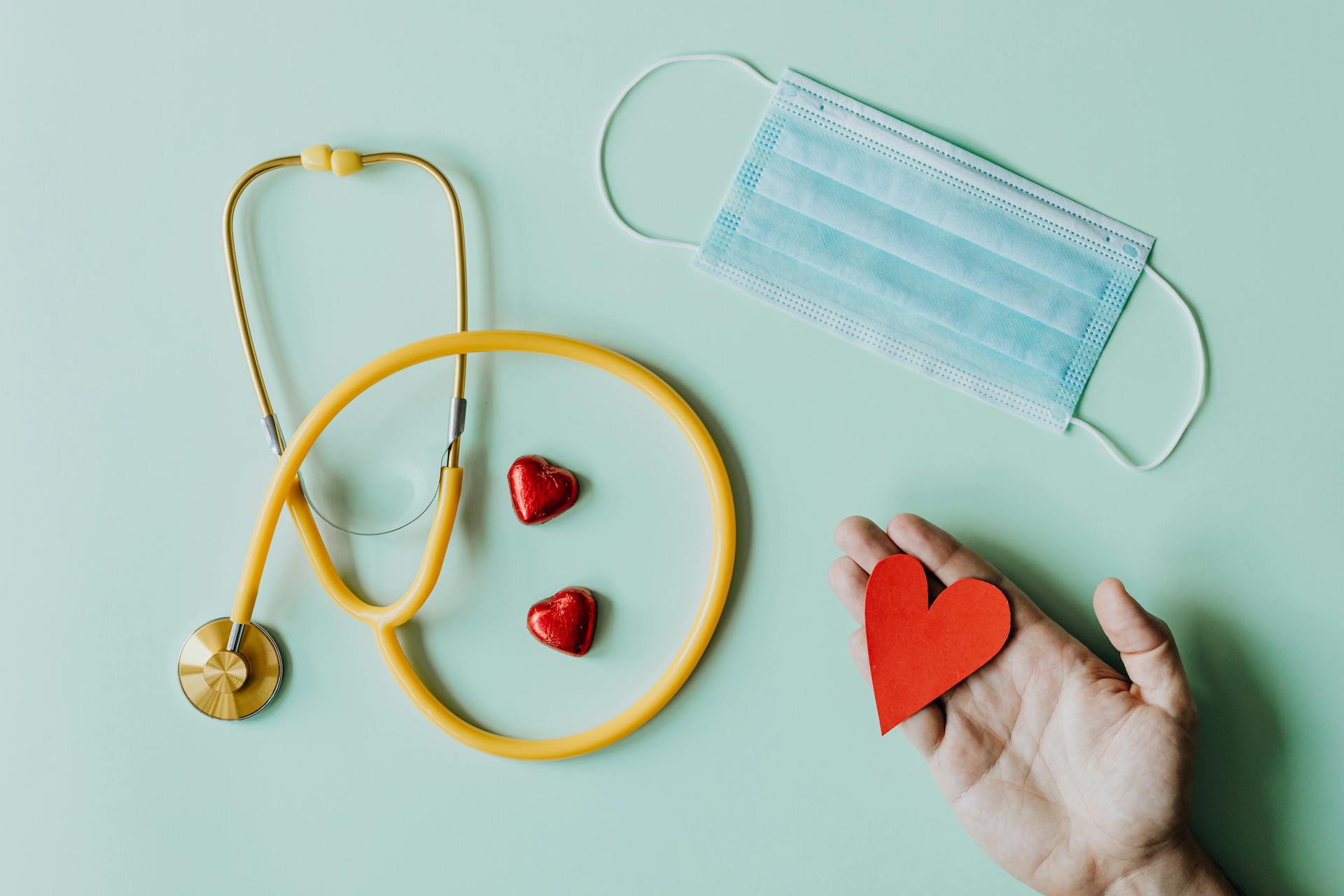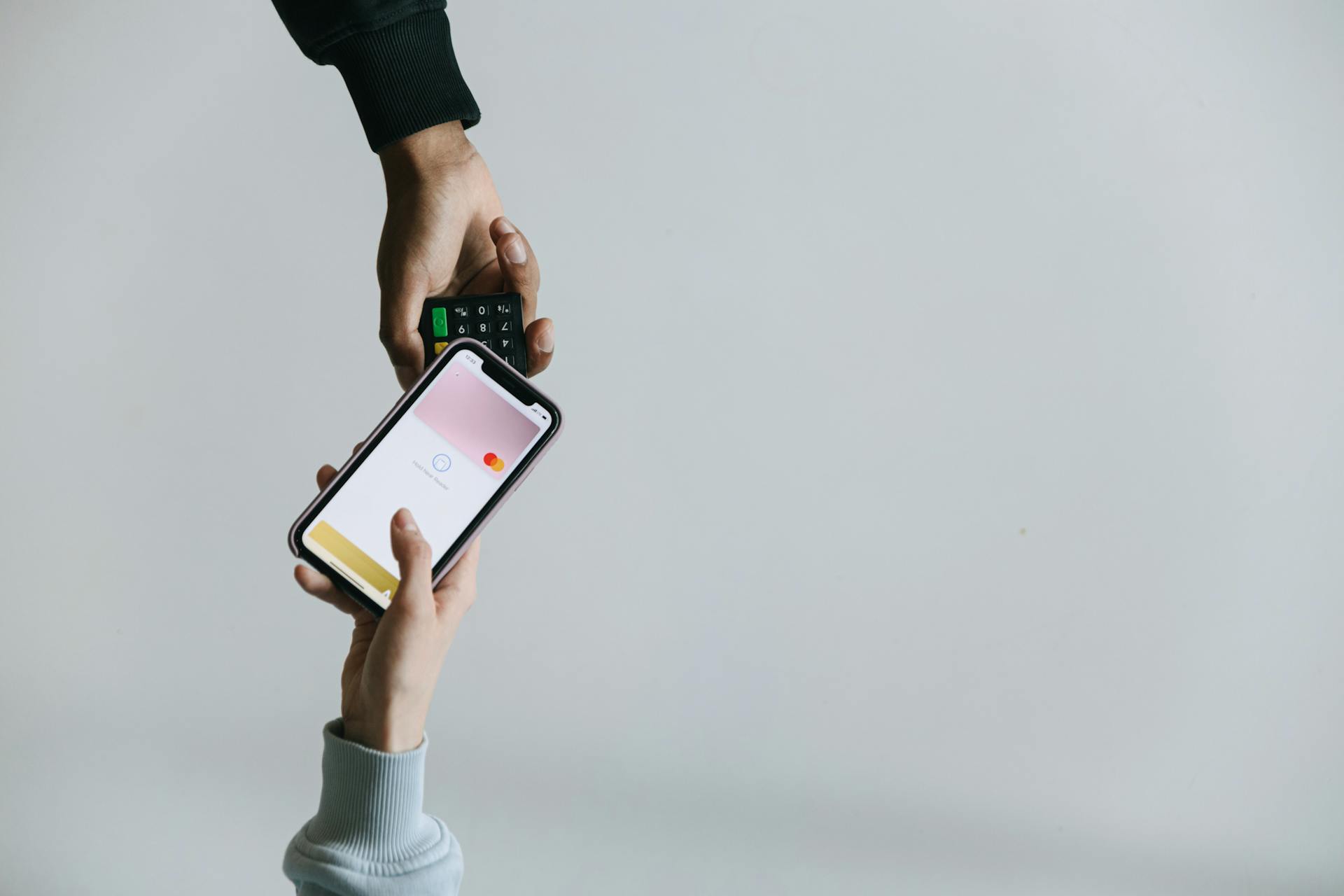
Unintentional HIPAA violations can happen to anyone, and they often result from simple mistakes or oversights. Posting patient photos on social media without consent is a common example.
Discussing a patient's condition with a family member in a public place can also lead to a HIPAA breach. This happened to a hospital employee who shared a patient's diagnosis with a family member in a coffee shop.
HIPAA regulations are complex and can be difficult to navigate, especially for small healthcare providers with limited resources. One such provider was fined $150,000 for violating HIPAA rules due to a lack of proper training.
These fines can be devastating for small businesses, which is why it's essential to take preventive measures to avoid unintentional HIPAA violations.
For another approach, see: How to Prevent Hipaa Violations
What Are Unintentional HIPAA Violations?
Unintentional HIPAA violations can happen to anyone, even with the best intentions. Improperly disposing of PHI is a common mistake that can lead to serious consequences.
Sending emails containing PHI to the wrong address is another unintentional HIPAA violation that can occur. This can happen when employees are in a hurry or not paying attention to the recipient's email address.
Accidentally sharing PHI via email or social media is a serious mistake that can happen in an instant. It's essential to be mindful of what we share online, even if it's just a casual conversation.
Losing control of unencrypted devices containing PHI is a major concern for healthcare organizations. This can happen when devices are left unattended or not properly secured.
Employees accessing information without authorization out of curiosity or by mistake is a breach of HIPAA rules. This can lead to serious consequences, including fines and penalties.
Here are some common unintentional HIPAA violations to watch out for:
- Improperly disposing of PHI
- Accidentally sharing PHI via email or social media
- Sending emails containing PHI to the wrong address
- Losing control of unencrypted devices containing PHI
- Employees accessing information without authorization
Not securing patient information is a critical mistake that can lead to data breaches. This includes not logging out of computers and not providing adequate employee training.
Overlooking the minimum necessary information standard is another unintentional HIPAA violation that can occur. This can happen when employees are not trained to handle sensitive patient information.
Accidentally disclosing PHI in conversation is a serious mistake that can happen in a split second. It's essential to be mindful of what we discuss in public, even if it's just a casual conversation.
Explore further: Are Invoices Considered Private Information Hipaa
Examples of Unintentional HIPAA Violations
Accidentally sharing PHI via email or social media is a common HIPAA violation that can occur when a healthcare provider or staff member shares patient information on a social media platform.
Sending emails containing PHI to the wrong address is also a violation, as it constitutes unauthorized access to protected patient data.
Failing to provide a notice of privacy practices, neglecting to obtain business associate agreements, and adding clients to newsletter lists without their consent are other unintentional HIPAA violations.
Here are some examples of unintentional HIPAA violations:
- Accidentally sharing PHI via email or social media
- Sending emails containing PHI to the wrong address
- Failing to provide a notice of privacy practices
- Neglecting to obtain business associate agreements
- Adding clients to newsletter lists without their consent
These violations can result in fines, penalties, and legal consequences, making it essential for healthcare providers to be aware of the risks and take steps to prevent them.
What Is a Violation?
A HIPAA violation occurs when an organization fails to comply with HIPAA standards and rules. This can happen in many ways, including unintentionally accessing or disclosing a patient's protected health information (PHI).
The Office of Civil Rights (OCR) investigates HIPAA violations, and depending on the severity of the violation, there can be fines, penalties, and legal consequences. The OCR is responsible for ensuring that organizations comply with HIPAA regulations.
Protected Health Information (PHI) includes a wide range of identifiable information, such as medical records, test results, prescriptions, and social security numbers. This information is sensitive and must be protected.
HIPAA laws aim to modernize healthcare information in an era of digital records, and they delineate patient data privacy regulations by requiring security measures around access to healthcare information. This includes three primary rules: the Privacy Rule, the Security Rule, and the Breach Notification Rule.
The Privacy Rule regulates how PHI can be used and disclosed, while the Security Rule requires organizations to implement administrative, technical, and physical safeguards to protect PHI. The Breach Notification Rule requires organizations to notify patients if their PHI has been compromised.
Curious to learn more? Check out: Hipaa 3 Rules
HIPAA violations can occur in various ways, including not training staff or monitoring access logs. This can lead to unauthorized access to PHI, which is a serious HIPAA violation.
The following types of organizations are considered "covered entities" and must comply with HIPAA regulations:
- Hospitals
- Insurance companies
- Healthcare clearinghouses
- Cash-only providers who don’t do business with insurance organizations
These organizations must implement policies and procedures to protect PHI and prevent unauthorized access. They must also train their staff on HIPAA regulations and monitor access logs to ensure compliance.
Sharing via Insecure Methods
Sharing via insecure methods is a common way to unintentionally violate HIPAA rules. This can happen when healthcare providers or staff members share patient information using unsecured networks, such as public Wi-Fi or personal devices without encryption.
Texting, video conferencing applications, phone calls, and personal emails are all considered insecure methods for sharing patient information. According to HIPAA's security rule, patient information must be shared securely to uphold its privacy. Sharing patient information through these methods can result in e-PHIs being readily available on the network for security breaches and attacks.
Sharing patient information through common file-sharing services is also a HIPAA violation. This can happen when healthcare providers or staff members use these services to share patient information without proper security measures in place.
Here are some examples of insecure methods for sharing patient information:
- Texting patient information
- Using video conferencing applications to share patient information
- Sharing patient information over public Wi-Fi
- Using personal devices without encryption to share patient information
- Sharing patient information through common file-sharing services
These methods can put patient information at risk of being accessed by unauthorized individuals, which is a serious HIPAA violation. To avoid these violations, healthcare providers and staff members must use secure methods for sharing patient information, such as encrypted email or secure online portals.
Causes of Unintentional HIPAA Violations
Improperly disposing of PHI is a common cause of unintentional HIPAA violations. This can happen when employees don't follow proper procedures for disposing of sensitive patient information.
Accidental sharing of PHI via email or social media is another frequent mistake. This can happen when employees click on a phishing email or post patient information online without thinking.
Broaden your view: Phi Meaning in Hipaa
Not logging out of computers is a simple mistake that can lead to unauthorized access to PHI. An unlocked computer screen can result in an unintentional HIPAA violation.
Here are some common causes of unintentional HIPAA violations:
- Improperly disposing of PHI
- Accidentally sharing PHI via email or social media
- Sending emails containing PHI to the wrong address
- Not logging out of computers
- Not providing adequate employee training
Computer Session Management
Computer Session Management is a crucial aspect of preventing unintentional HIPAA violations. Improperly managing computer sessions can lead to unauthorized access to Protected Health Information (PHI).
Leaving a computer unlocked or unattended can result in employees accessing information without authorization, out of curiosity or by mistake. This can lead to a HIPAA violation.
Not logging out of computers is a common mistake that can be avoided. An unlocked computer screen can result in unauthorized access to PHI and an unintentional HIPAA violation.
Here are some common mistakes to watch out for:
- Not logging out of computers
- Leaving computers unlocked or unattended
These simple errors can have serious consequences. It's essential to educate employees on the importance of proper computer session management to prevent HIPAA violations.
Inadequate Employee Training
Lack of proper training is a major reason for unintentional HIPAA violations.
Inadequate employee training is a common cause of HIPAA violations, often resulting from a lack of understanding about proper privacy, security, and confidentiality practices.
According to HIPAA compliance requirements, healthcare employees need to be trained about the proper handling of PHI.
This lack of training can lead to employees unintentionally violating HIPAA rules and regulations.
Not providing adequate employee training is a serious issue that can result in unintentional HIPAA violations, as employees are unaware of the appropriate HIPAA rules and regulations.
A unique perspective: Hipaa Violation Penalties for Employees
Consequences of Unintentional HIPAA Violations
If you accidentally violate HIPAA, you may face penalties, depending on the severity and other factors. Unintentional HIPAA violations can result in fines, sanctions, and employment termination, as well as reputational harm and loss of patient trust.
HIPAA violations are typically classified into four tiers, with increasing penalties for more severe violations. For example, a Tier 1 violation, which occurs unknowingly, carries a minimum penalty of $137 per violation.
The minimum penalty for a Tier 2 violation, which occurs due to reasonable cause, is $1,379 per violation. This is a significant increase from Tier 1, and highlights the importance of proper training and adherence to HIPAA rules.
Tier 3 and Tier 4 violations, which occur due to willful neglect, carry much higher penalties: $13,785 and $68,928 per violation, respectively. These penalties demonstrate the serious consequences of intentionally or recklessly violating HIPAA rules.
Here's a breakdown of the four tiers of HIPAA violations and their corresponding penalties:
In addition to these penalties, a HIPAA violation can also result in employment termination, especially if the breach was not in good faith. The results of an internal investigation, the scope of the breach, and the employee's role in it are all factors in the ultimate outcome.
On a similar theme: What Is the Hipaa Breach Notification Rule
Preventing Strategies and Best Practices
Implementing robust security awareness and training about HIPAA rules and regulations is a crucial strategy for preventing unintentional HIPAA violations. This training should include employees, contractors, and volunteers to ensure everyone is on the same page.
Regular staff training is essential, but it's not enough on its own. You should also consider implementing strict access controls to limit who can access sensitive patient information.
Using encryption is another key step in protecting patient data. This means encrypting not only electronic data but also physical files and devices.
Performing a comprehensive risk analysis at least once a year can help identify potential vulnerabilities and prevent HIPAA violations. This analysis should be thorough and cover all areas of your organization.
Before disclosing patient information to third parties, confirm that they are equipped to protect patient data. This includes ensuring they have their own HIPAA-compliant policies and procedures in place.
Creating clear policies about technology and social media use is essential for preventing HIPAA violations. These policies should be publicly available and easily accessible to all employees.
Assigning a privacy and compliance officer can help answer questions, provide training, and conduct risk assessments. This officer can also help manage reports and risk analyses.
Here are some key steps to prevent HIPAA violations:
- Implement strict access controls
- Use encryption
- Perform a comprehensive risk analysis at least once a year
- Confirm that third parties can protect patient data
- Create clear policies about technology and social media use
- Assign a privacy and compliance officer
Notable HIPAA Breaches
The University of Mississippi Medical Center (UMMC) faced a $2.75 million fine for a HIPAA breach involving unsecured ePHIs of approximately 10,000 individuals.
UMMC knew about the risks since long but failed to address them until after the breach, and they didn't even notify affected individuals whose ePHI was believed to have been accessed or disclosed.
The Children's Medical Center in Dallas suffered a loss of $3.2 million due to a stolen Blackberry device that had no password protection or encryption, resulting in the loss of 3,800 PHI data.
This is one of the worst breaches in US healthcare history, highlighting the importance of ensuring adequate security precautions to protect health information.
In another case, a hospital employee accidentally left protected patient information in a public location, such as a hospital cafeteria, which is a common HIPAA violation example.
This incident shows that even small mistakes can lead to significant consequences, emphasizing the need for vigilance in protecting patient information.
Common Mistakes and Errors
Accidentally faxing sensitive patient information to the wrong fax number can lead to HIPAA violations, just like sending information to the wrong email or physical address.
Leaving protected patient information in a public location, such as a hospital cafeteria, can also result in a violation.
Faxing PHI to the wrong fax number can be a serious mistake, especially if unauthorized individuals at the correct fax number see the information.
Transmitting PHI over an unsecured Wi-Fi network can put patient information at risk of being accessed by unauthorized individuals.
Accidentally leaving protected patient information in a public location can be as simple as forgetting a laptop or tablet with PHI in a public area.
Not securing patient information by using unencrypted personal devices or USB drives to download patient information can also lead to a violation.
Consider reading: Does a Clinic Phone Number Need to Be Hipaa Compliant
Responding to HIPAA Violations
If you accidentally violate HIPAA, you could face penalties, fines, and even employment termination. The severity of the penalty depends on factors like whether it was intentional or not.
HIPAA violations are typically classified into four tiers, with varying penalties. Here's a breakdown of the tiers:
If you're unsure whether a breach is reportable, consider the following: if the breach involves unsecured PHI accessed in a way that violates the privacy rule, you need to report it.
When to Self-Report a Violation
Self-reporting a HIPAA violation is a crucial step in maintaining transparency and trust with patients. If you're unsure whether to report a breach, consider this: breaches that demand reporting under HIPAA involve unsecured PHI that's accessed in a way that violates the privacy rule.
In such cases, business associates and individuals must report breaches to covered entities within 60 days. If the breach involves fewer than 500 records, covered entities have 60 days to report it to HHS, but organizations must report larger breaches immediately.
The scope of the breach and the employee's role in it are also important factors to consider when deciding whether to self-report a violation. If the breach was accidental and "in good faith", HIPAA rules may not designate the breach as reportable.
Expand your knowledge: How to Report Hipaa Violation
Responding to Negative Online Review
Responding to Negative Online Review can be a delicate matter. Manasa Health Center, a psychiatric service provider in New Jersey, learned this the hard way when they disclosed a patient's protected health information in response to a negative online review.
This action led to a violation of HIPAA Privacy Rules. They failed to implement proper policies and procedures to handle such situations.
In this case, the Health Center paid $30,000 to settle the case with HHS. They also agreed to a corrective action plan to ensure future compliance.
It's essential to remember that responding to negative reviews requires a thoughtful and careful approach.
Financial and Legal Consequences
Accidental HIPAA violations can result in significant financial and legal consequences. Fines for violations range from $100 to $50,000 per incident, with an annual maximum of $1.5 million for repeated offenses.
If you're unlucky, you might face criminal penalties, including fines up to $250,000 and imprisonment for up to ten years. The severity of the penalty depends on the nature and severity of the violation.
Expand your knowledge: Can You Go to Jail for Hipaa Violations
HIPAA violations are typically classified into four tiers, with penalties ranging from $137 to $68,928 per violation. The tier classification is based on the severity of the violation, with the lowest penalty for unintentional violations.
Here's a breakdown of the four tiers and their corresponding penalties:
The good news is that unintentional HIPAA violations can still be corrected and avoided in the future. However, it's essential to be aware of the potential consequences and take steps to prevent violations from happening in the first place.
Sources
- https://www.jotform.com/blog/examples-of-unintentional-hipaa-violations/
- https://www.strongdm.com/blog/hipaa-violation-examples
- https://sprinto.com/blog/examples-of-hipaa-violations/
- https://helloalleva.com/what-is-a-hipaa-violation-26-examples
- https://www.hipaaguide.net/examples-of-unintentional-hipaa-violations/
Featured Images: pexels.com


